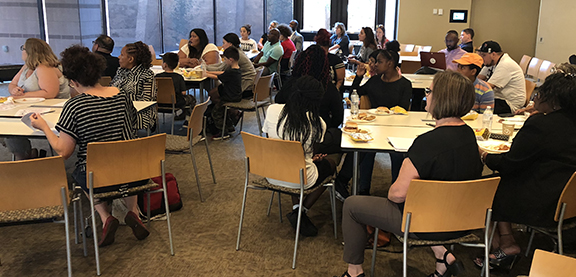
By Camille Erickson
Throughout nearly three decades of involvement in criminal justice reform, Laura LeBlanc worked diligently to create what she calls a “strong and deliberate moat” around correctional systems to protect youth.
Having witnessed the irreversible impact incarceration can have on Native youth and youth of color in her life, LeBlanc helps lead Oyate Hotanin (Voice of the People) and InEquality, movements using art and healing to oppose the prison industrial complex and envision community-initiated alternatives to incarceration.
“Only the community who has been policed, prosecuted, charged and incarcerated knows how this system is broken,” she said. “Without us, we have not seen reform.”
But in May 2018, LeBlanc said she saw her efforts undermined as Saint Paul Public School, Ramsey County and the city of Saint Paul passed a joint powers agreement allowing unprecedented data-sharing between the entities. The agreement allows the groups to share data with the hope of providing better support to students deemed “at-risk” for future contact in the criminal justice system.
The National Council on Crime and Delinquency (NCCD), an organization conducting research on juvenile justice, selected a proposal submitted by Ramsey County to “reduce juvenile justice involvement through predictive analytics,” according to the joint powers agreement. NCCD will provide technical assistance to evaluate data and identify factors to predict a child’s likelihood of succeeding in school or falling into the criminal justice system.
But a group of parents, educators and civil rights advocates have formed a coalition to resist the data-sharing agreement. Opponents point to the agreement’s reliance on what they see as racially-biased indicators to collect data, its violation of families’ privacy and its over-broad terms that could lead to future abuses of data. They are now urging the involved entities to back out and dissolve the joint powers agreement.
“The data-sharing appears to be a serious breach of our stated intention,” said LeBlanc. “It felt like it was building a bridge across the moat.”
Collaborating and sharing data to better support students
Initiated by the Ramsey County Attorney’s Office, the joint powers agreement stated that collaborative data-sharing would “connect students who are struggling with community- and system-based resources to improve success in school and in life and prevent interaction with the juvenile justice system.”
Cedrick Baker, chief of staff at Saint Paul Public Schools and a district representative for the joint powers agreement, explained that the school district supported the agreement with the goal of helping students.
“A lot of times [the entities] are dealing with some of the same kids,” said Baker. “How can we do a better job of coordinating our efforts to ensure that we are getting the right resources and attention to students earlier on so that they don’t have contact with the juvenile justice system?”
By collecting relevant data and pinpointing indicators of risk using school, city and Ramsey county records, advocates for the agreement want to flag students at an earlier stage who might be at risk of struggling in school or getting caught up in the justice system.
Ironically, advocates think the agreement could have the exact opposite impact and make Native students and other students of color more likely to be targeted by law enforcement or singled out by teachers.
LeBlanc is also a community representative at the Ramsey County Juvenile Detention Alternative Initiative, a reform table for juvenile justice. When it comes to the joint powers agreements, LeBlanc said she has never seen anything this broad in scope passed in the city.
To Marika Pfefferkorn, the director of the Midwest Center for School Transformation, the agreement just extended the school to prison pipeline by criminalizing students at an even younger age. “This is the next iteration of the school to prison pipeline as we go into our digitized environment,” she said.
Pfefferkorn predicted that this broad data-collection initiative would escalate racial profiling, stigmatize families and divert needed resources away to surveillance and data collecting at the expense of existing services.
Reliance on racially-biased indicators
The joint powers board has yet to convene and clarify what data will in fact be shared across institutions for the purpose of identifying children at-risk of involvement in the criminal justice system.
To Pfefferkorn, the lack of specificity is particularly troubling.
“The way that the agreement stands today, any piece of data, any variable, any indicator could be added at any time because there are no parameters on the agreement,” she said.
With minimal limitations listed explicitly in the agreement, critics fear the use of what they consider racially-biased indicators – school attendance, police contacts, suspensions, or child protection cases – as possible points of data.
Pfefferkorn believes that relying on data such as suspensions or attendance records to determine risk will disproportionately impact students of color, American Indian students and their families.
Khulia Pringle, a mother, educator and leader of the coalition to stop “the cradle to prison pipeline” pointed to a 2018 study from the Department on Human Rights that found the disciplinary procedures at Saint Paul Public School unjustly impacted students of color. The analysis concluded that American Indian students were 10 times more likely to be suspended or expelled than their white counterparts. Black students were punished at eight times the rate of white students.
According to Pringle, using data such like disciplinary rates to label Indigenous students and students of color as “at-risk” for criminal involvement would only exacerbate the issue of their over-representation in correctional systems.
As it stands, the agreement makes no commitment to correct for racial bias.
Organizers also referenced the prevailing distrust that marginalized communities in the city have towards social services, law enforcement and prosecutors given histories of repeated abuse by such agencies against American Indian people and people of color.
Efforts for community engagement did occur in 2015, as the city and county organized a series of meetings. Pringle attended some meetings with her daughter. But she walked away feeling like her recommendations were misunderstood by city officials and ultimately misused to justify the advancement of the agreement.
“I was involved in one of their so called ‘community engagements,’” said Pringle. “Personally, this made me upset because I felt like my voice was used as a reason for coming up with this joint powers agreement.” Pfefferkorn asserted that community members’ pushback is justified based on decades of mistrust and a lack of transparency.
Risks of relying on predictive analytics
The lack of clarity around how the agreement will be used led critics to fear the worst. Pfefferkorn pointed to the potential use of the data to develop predictive analytics, or a system, which in this case, could use historical data to provide insight into how children might behave in the future.
Data 4 Black Lives is an organization working to advance data use in ways that improve and protect Black lives. At a recent public webinar organized by the national organization Dignity in Schools Campaign, Yeshimabeit Milner of Data 4 Black Lives spoke to the potential risks of Ramsey County’s plan to share data.
She affirmed that data can be both a tool for good, but also a tool for abuse, referencing instances when predictive analytics have been misused. She cautioned that there are lessons to be learned from this history, and discretion should be used before mining children’s data.
“I do believe that algorithms and data in a vacuum is neutral, but when you put it in a context of the school-to-prison pipeline of generations and histories of racism and oppression, it takes on a whole other meaning,” said Milner.
Using data to establish predictive analytics is not new and remains prevalent. This method is used to predict optimal credit scores, build advertisements or detect fraud, among other uses.
The Chicago Police Department’s Strategic Subject List, or “heat list” started in 2012, is an oft-cited example of predictive analytics. The department used data and algorithms to develop a list of individuals who might be “at-risk” for involvement in a shooting. However, an audit of the SSL by the RAND Corporation, published in the Journal of Experimental Criminology, found that this strategy had minimal impact on preventing violence.
“Algorithms themselves are designed by humans, leaving open the possibility that unrecognized human bias may taint the process,” wrote attorney and professor Andrew Guthrie Ferguson in his book about data use in policing and surveillance.
But according to Baker, the joint powers board is proceeding with caution and has yet to decide if they plan to implement predictive analytics. “Speaking on behalf of Saint Paul Public Schools,” he said, “I want the community to know that we hear them, and that there are some concerns that have been raised. We want to ensure that they get answers to their questions.”
Anne Barry, director of public health at Ramsey County, who is now responsible in part for overseeing the agreements’ formation, said she understands the concerns of community members, too. “I hate saying, ‘trust us,’ because I can see every reason why the community doesn’t trust us,” said Barry. “But they are going to have to see it in the actions.”
Barry said she intended to address concerns and questions by working with the community to seek recommendations in upcoming sessions. Barry also acknowledged community complaints that the meetings several years ago, which Pringle attended, were insufficient, and that feedback from community members was either ignored or misconstrued when developing the data-sharing agreement.
“What we heard from the community was, ‘you didn’t even listen to us, in fact you took our words and misused them turned them into a support a data sharing agreement,’” said Barry. She called the previous community engagement process “very limited” and said the agreement failed to reflect community input. She said the board remains open to revisions. “We are willing to change this agreement and change the words to more accurately accomplish what we what from this work.”
Although Barry is involved in the rollout of the joint powers agreement, the specifics of the agreement will be determined by the joint powers board.
Joint powers board seeks community input
In response to organizers’ concerns, Mayor Melvin Carter of Saint Paul released a letter on Oct. 5 addressed to community members including Tyrone Terrill, president of African American Leadership Council; Dianne Binns, president of the city’s NAACP branch; and Reverend Dr. James Thomas.
“At this juncture, in response to the feedback we have heard from you, and others in our community, including the substantial concerns that have been raised related to predictive analytics, and the potential harm from misuse of data, we have decided to revise our timeline to allow for more community input,” said the letter.
The joint powers board consists of members of the Saint Paul Public School Board, the Superintendent of the school district, the County Attorney, among other public officials. Community members are not allowed to sit on such boards, further barring public input and oversight.
According to Minnesota Statute 471.59, “the joint board established under this subdivision must be composed solely of members of the governing bodies of the governmental unit that established the joint board.”
Baker said one possibility to ensure public input is funneled to the board will be to have a community advisory board.
To LeBlanc, even an alternative such as an advisory board would be insufficient. “Since we have such serious concerns with the joint powers agreement, we don’t want to join an advisory board where we are watchdogging that they won’t hurt us indefinitely,” she said.
The next meeting on the Cradle to Prison Algorithm will be held November 10th, 8:30am- 3:30pm at St. Paul College. For info, contact: info@tciamn.org.






